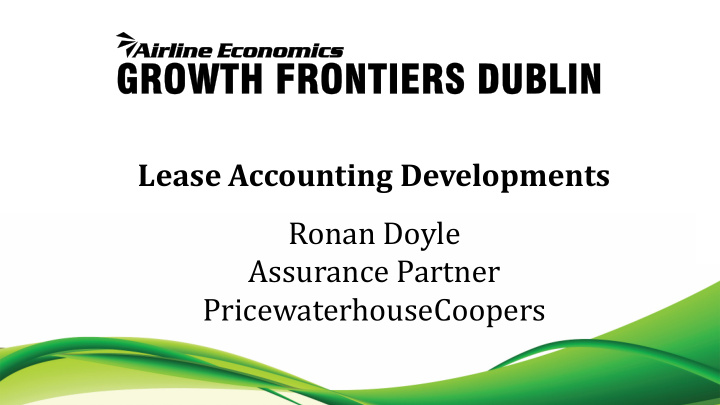



Lease Accounting Developments Ronan Doyle Assurance Partner PricewaterhouseCoopers
Lea se Accounting The end of the w orld a s w e know it ? Ronan Doyle – 20 January 2016
Agenda • What has changed • Practical implications • Results of field test on the likely impacts • Suggestions on how to respond • Q&A Slide 3
A change that is 30 years in the m aking • Traditionally, much of the world’s leased assets were “off balance sheet” for their operators Reporting rule adds $3tn of leases to balance sheets – Hides leverage – Undisclosed commitments globally. – Lack of comparability within industry A new financial reporting standard — the culmination of decades of debate over “off- balance sheet” financing — will affect more • New rules will end this treatment – bringing all leases back on than one in two public companies globally. balance sheet of lessees FT – 13 January 2016 • Rents will be replaced by interest costs and depreciation (as if asset were owned) The distinction between operating leases and finance leases that is required by present standards is arbitrary and unsatisfactory. The comparability (and • International accounting rules final and effective 1 January 2019 (but hence usefulness) of financial statements would be can adopt earlier) enhanced if the present treatment of operating leases and finance leases were replaced by an approach that • applied the same requirements to all leases. US GAAP rules not yet finalized – likely before end of Q1 2016 Accounting for leases – a new approach (1996) Slide 4
The Highlights – IFRS 16 • Lessees will be required to 1. Recognise a lease liability for present value of future lease payments 2. Recognise a right of use asset reflecting the benefit to be gained from the leased asset over the term of the lease • The calculation of the asset and liability are tightly defined 1. Use of Asset vs Service Costs 2. Fixed vs Variable Rents 3. Term of the Lease 4. Discount Rate 5. Contingent Rents 6. Costs of Restoration • Subsequent accounting comprises an interest charge on the liability and amortization of the asset • Some limited exemptions for smaller/ short term assets • Direct impact on lessors less significant (change in definition of a lease) but significant secondary impacts likely • US GAAP likely to permit straight line accounting in the income statement in certain cases Slide 5
Illustrative Exam ple under IFRS 16 - Lessee 2001 2002 2003 2004 2005 2006 2007 2008 2009 2010 Total Depreciation 1,554 1,554 1,554 1,554 1,554 1,554 1,554 1,554 1,554 1,554 15,540 Interest Expense 1,019 955 883 805 719 624 520 406 282 147 6,359 Combined Expense 2,573 2,509 2,437 2,359 2,273 2,178 2,074 1,960 1,836 1,701 21,899 Current Accounting 2,190 2,190 2,190 2,190 2,190 2,190 2,190 2,190 2,190 2,190 21,899 Impact on Profit and Leverage - (200) (400) (600) (800) (1,000) Profit Impact (1,200) Leverage Impact (1,400) (1,600) (1,800) (2,000) 2001 2002 2003 2004 2005 2006 2007 2008 2009 2010 The chart above depicts the im pact on earnings and leverage for a basic 10 year lease w ith an initial annual rent of $2,000, a 2% annual escalation rate and an assum ed increm ental borrow ing rate of 7%. Slide 6
Practical Im plications Cha ng es from current May also im pact future Many KPIs are redefined: transactions: - Current ratio off b a la nce sheet - (re) financing or raising capital - Asset Turnover a ccounting to fund growth - Interest cover - Net income - Acquisitions and Mergers - Sale and leaseback - ROCE Balance Sheet - Lease versus buy decisions - ROE Assets - Operating cash flows Liabilities Incom e statem ent Lease expense Depreciation Interest expense Im pacting various Need to m anage arrangem ents: stakeholders: EBIT - Financing arrangements and - Banks/ lenders EBITDA covenants - Investors/ analysts - Supply arrangements - Rating agencies EBITDAR - Remuneration and employee - Suppliers schemes - Management/ staff EPS - Tax arrangements - Tax authorities Cash flow statem ent - Hedging arrangements - Oversight bodies Cash from ops Cash from finance Slide 7
The potential im pact – field testing the requirem ents • PwC has completed a study of 3,199 entities who currently report under IFRS. • Using public information, we modelled the potential impact of the leasing standard. • Financial metrics and ratios (e.g. change in Debt, EBITDA, Leverage, Solvency) were recalculated. • Borrowing costs were estimated using a company’s credit rating to the extent available or determined a synthetic rating. • Results were analysed by industry and geography. • Similar studies which include US GAAP reporters typically show a slightly more pronounced effect in the airline industry. Slide 8
The potential im pact – field testing the requirem ents Slide 9
Suggestions on how to respond • Build awareness within and with customer base • Inventory of existing arrangements to identify scope/ benefit of changes • “Future proof” the terms of new leases • Options for renegotiation with lessees where change may be beneficial • Ancillary and knock on impacts on business opportunities • Develop and cost menu of options for front office • Build into pricing and risk assessments • Monitor impacts for tax and LILO structures Slide 10
Q&A Slide 11
Lea d ership in Glob a l Lea sing Ronan Doyle Partner - Assurance ronan.doyle@ie.pwc.com Telephone: +353 (0) 1 792 6559 Yvonne Thom pson Partner - Tax yvonne.thompson@ie.pwc.com Telephone: +353 (0) 1 792 7147 Brian Leonard Partner - Tax brian.a.leonard@ie.pwc.com Telephone: +353 (0) 1 792 6179
Recommend
More recommend